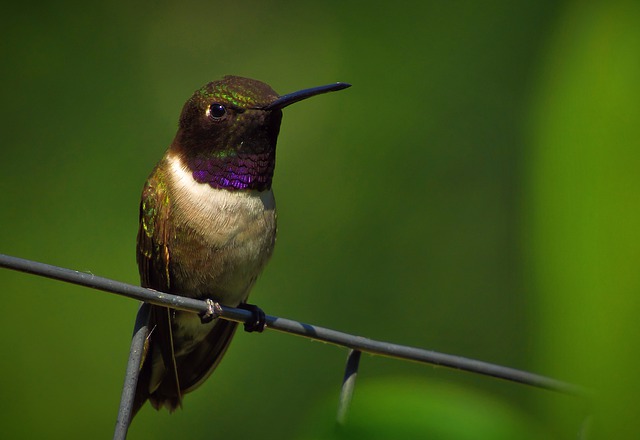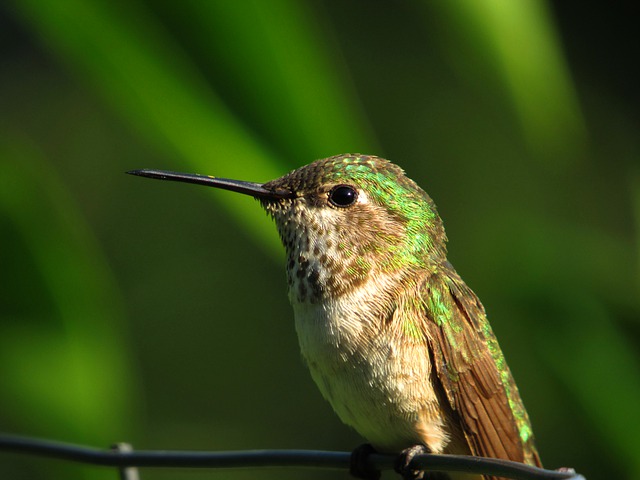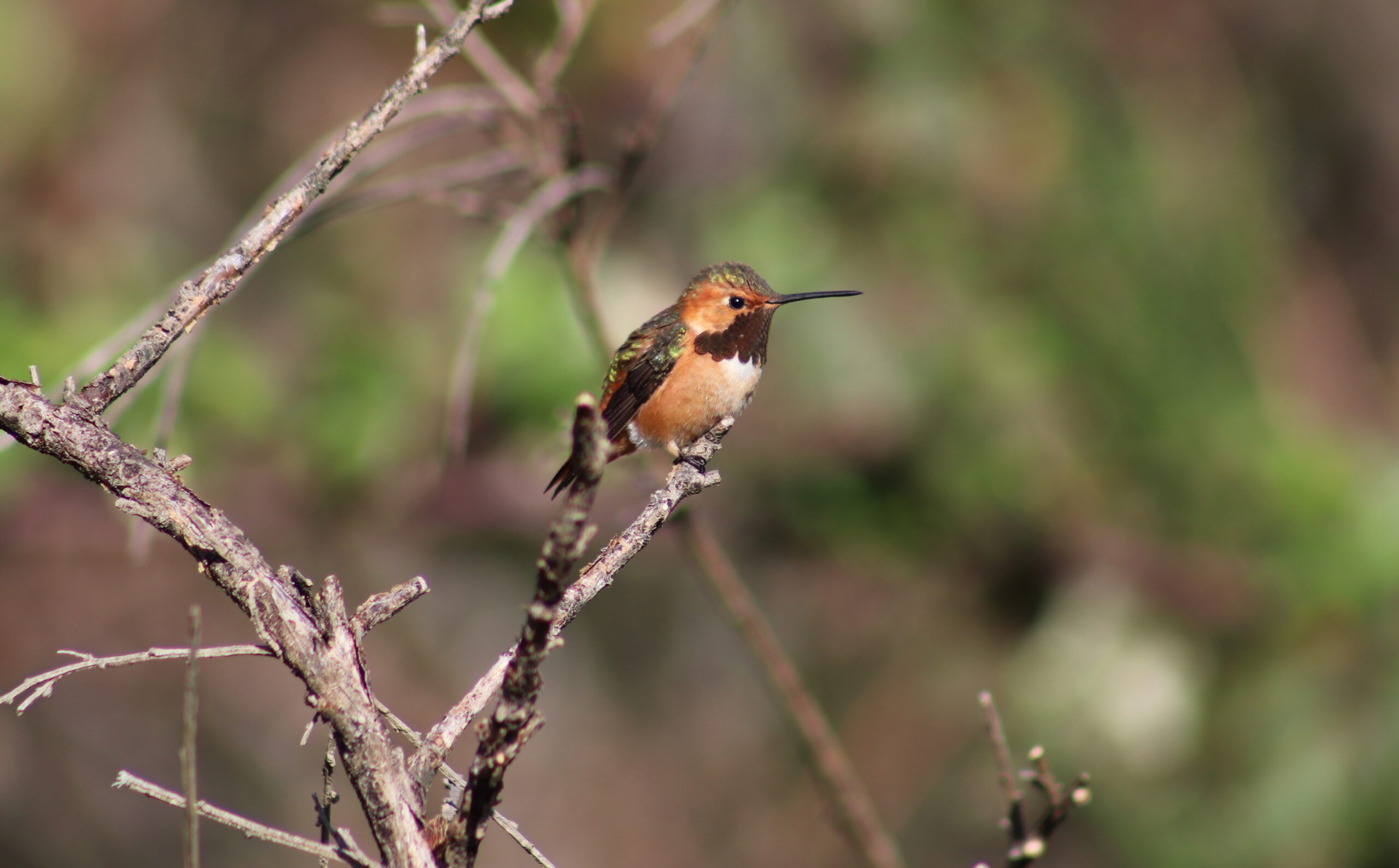Have you ever gazed in wonder at the graceful flutter of a hummingbird’s wings?
These tiny, iridescent creatures have captivated the hearts of bird lovers for centuries, and Pennsylvania is home to 7 different species of these fascinating birds.
From the shimmering Ruby-throated Hummingbird to the striking Rufous Hummingbird, each species has its own unique characteristics and behaviors.
So, grab your binoculars and join us as we explore the wondrous world of hummingbirds in Pennsylvania.
| Image | |
|---|---|
 | Ruby-Throated Hummingbird |
 | Black-Chinned Hummingbird |
 | Rufous Hummingbird |
 | Calliope Hummingbird |
 | Broad-Tailed Hummingbird |
 | Allen’s Hummingbird |
 | White-Eared Hummingbird |
 | Rufous/Allen’s Hummingbird |
Types of Hummingbirds in Pennsylvania (PA)
1. Ruby-Throated Hummingbird

The Ruby-throated (Archilochus colubris) Hummingbird is the most frequent species found in Pennsylvania.
It is the only species of hummingbird that nest across the eastern United States.
The male has a shiny metallic green back and a white chin, throat, and chest with a ruby-red patch on its throat.
The female is similar in color but lacks the ruby-red patch on its throat.
The Ruby-throated Hummingbird can be found in deciduous and coniferous forests, woodlands, and gardens.
It feeds on nectar from flowers, as well as insects and spiders.
2. Black-Chinned Hummingbird

The Black-chinned Hummingbird (Archilochus alexandri) is a migratory species of hummingbird that breeds in the western United States and winters in the southern United States and Mexico.
The male has a metallic green back and a black chin, throat, and chest.
The female is similar in color but has a greyish chin and throat.
The Black-chinned Hummingbird can be found in open woodlands, gardens, and near water sources such as streams and rivers.
It feeds on nectar from flowers, as well as insects and spiders.
3. Rufous Hummingbird

The Rufous Hummingbird (Selasphorus Rufus) is a migratory species of hummingbird that breeds in the western United States and winters in the southern United States and Mexico.
The male has a metallic green back and a rufous-colored chin, throat, and chest.
The female is similar in color but has a greyish chin and throat.
The Rufous Hummingbird can be found in open woodlands, gardens, and near water sources such as streams and rivers.
It feeds on nectar from flowers, as well as insects and spiders.
4. Calliope Hummingbird

The Calliope Hummingbird (Selasphorus calliope) is a migratory species of hummingbird that breeds in the western United States and winters in the southern United States and Mexico.
It is the smallest species of hummingbird found in the United States.
The male has a metallic green back and a rufous-colored chin, throat, and chest.
The female is similar in color but has a greyish chin and throat.
The Calliope Hummingbird can be found in open woodlands, gardens, and near water sources such as streams and rivers.
It feeds on nectar from flowers, as well as insects and spiders.
5. Broad-Tailed Hummingbird

The Broad-tailed Hummingbird (Selasphorus platycercus) is a migratory species of hummingbird that breeds in the western United States and winters in the southern United States and Mexico.
The male has a metallic green back and a rufous-colored chin, throat, and chest.
The female is similar in color but has a greyish chin and throat.
The Broad-tailed Hummingbird can be found in open woodlands, gardens, and near water sources such as streams and rivers.
It feeds on nectar from flowers, as well as insects and spiders.
6. Allen’s Hummingbird

The Allen’s Hummingbird (Selasphorus sasin) is a migratory species of hummingbird that breeds in the western United States and winters in the southern United States and Mexico.
The male has a metallic green back and a rufous-colored chin, throat, and chest.
The female is similar in color but has a greyish chin and throat.
The Allen’s Hummingbird can be found in open woodlands, gardens, and near water sources such as streams and rivers.
It feeds on nectar from flowers, as well as insects and spiders.
7. White-Eared Hummingbird

The White-eared Hummingbird (Hylocharis leucotis) is a migratory species of hummingbird that breeds in the western United States and winters in the southern United States and Mexico.
The male has a metallic green back and a white patch on his cheeks.
The female is similar in color but has a greyish chin and throat.
The White-eared Hummingbird can be found in open woodlands, gardens, and near water sources such as streams and rivers.
It feeds on nectar from flowers, as well as insects and spiders.
How to Attract Hummingbirds?

1. Hummingbird Feeders
Hummingbird feeders are a great way to attract hummingbirds to your yard.
Hummingbird feeders should be filled with a nectar solution made from four parts water and one part white sugar.
The feeders should be placed in an area that is protected from the wind, near trees or shrubs for perching, away from windows, and in the shade.
The feeders should be cleaned regularly and the nectar solution should be changed every few days to prevent mold and bacteria from forming.
Hummingbirds are attracted to bright colors, so it is also a good idea to hang a bright red or pink ribbon or flag near the feeder to attract them.
2. Hummingbird Gardens
Creating a hummingbird garden is another great way to attract hummingbirds to your yard.
Hummingbird gardens should include flowering plants that provide nectar, such as bee balm, columbines, cardinal flowers, bee plants, and trumpet vines.
It is also important to provide perches and shelter for hummingbirds.
This can be done by planting shrubs and trees, as well as providing man-made structures such as birdhouses and birdbaths.
Hummingbirds are also attracted to bright colors, so it is a good idea to include brightly colored flowers in your garden as well.
3. Hummingbird Season
Hummingbirds in Pennsylvania typically migrate south in the fall and return in the spring.
The exact timing of the migration varies depending on the species, with the Ruby-throated Hummingbirds typically migrating in late August or early September and returning in late April or early May.
The other species of hummingbirds typically migrate in late September or early October and return in late April or early May.
Conclusion
In conclusion, Pennsylvania is a hummingbird-lover’s paradise, with seven unique species of these tiny, fascinating birds.
From the common Ruby-throated Hummingbird to the rare Black-chinned Hummingbird, each species adds its own special touch to the state’s rich birdlife.
Whether you’re a seasoned birder or just starting to appreciate these incredible creatures, Pennsylvania offers endless opportunities for hummingbird-watching and learning.
So, next time you see a flash of iridescent feathers, take a moment to appreciate the beauty and wonder of Pennsylvania’s hummingbirds.
FAQ
When is the best time to see hummingbirds in Pennsylvania?
The best time to see hummingbirds in Pennsylvania is during the spring and summer months, from April to September.
How can I attract hummingbirds to my yard?
You can attract hummingbirds to your yard by providing food, water, and shelter. Offer nectar-rich flowers, a hummingbird feeder filled with a solution of four parts water to one part white sugar, and a place for them to rest and nest.
How do I identify different species of hummingbirds in Pennsylvania?
You can identify different species of hummingbirds in Pennsylvania by their size, color, and markings. Pay attention to the shape of the bird’s bill, the color of its throat, and the pattern of its feathers.
Do hummingbirds migrate to Pennsylvania?
Yes, hummingbirds migrate to Pennsylvania during the spring and summer months, and then head back to their wintering grounds in Central America and Mexico in the fall.
Are hummingbirds endangered in Pennsylvania?
No, hummingbirds are not endangered in Pennsylvania, but some species are facing threats from habitat loss, disease, and climate change. It’s important to take steps to protect their habitats and provide them with food and shelter.
Last Updated on March 22, 2023 by Lily Aldrin

TY for this information. I’ve cleaned my feeders and waiting for their arrival. NE PA near NY border. 4-20-23.
I don’t understand, only the ruby-throated is here in PA, yet you say the others that are only in the west are seen here. The other 6 do not come to the Eastern part of the US where PA is unless they are really lost. More like “1 Type of Hummingbirds in Pennsylvania (PA)”